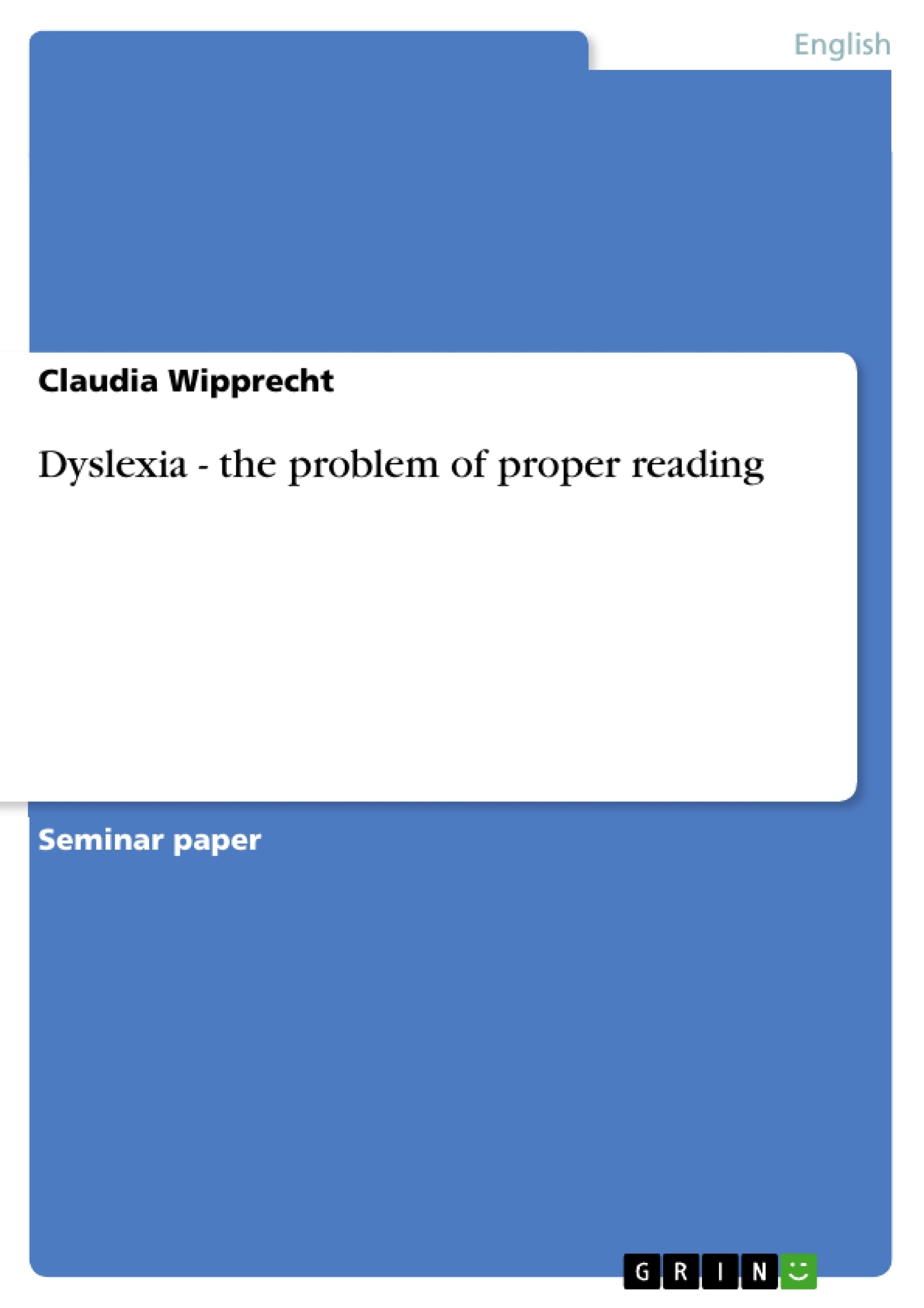Reading is not considered a natural skill but has to be acquired. Many people consider this proficiency ‘world class’ (Nicolson/Fawcett, 2001: 146). However, a lot of people have problems with acquiring this skill due to several difficulties, mostly subsumed under the term of ‘dyslexia’.
Developmental dyslexia is seen as the most common developmental disorder in Western school populations and affects four times as many boys as girls (Fawcett, 2002: 265). It was not until the 1970’s that dyslexia has been recognized as a specific learning difficulty. Rutter et al. (1970) and Yule et al. (1974) established specific reading difficulties and contributed to the acceptance of dyslexia. The problems were seen either extrinsic to the child, e.g. to do with society and school teaching, or intrinsic, i.e. within the child, which were to do with intelligence and gross neurological problems.
By 1989 the International Dyslexia Association provided an expanded and clearer definition that highlights the range of difficulties dyslexic students may experience:
“Specific Learning Difficulties can be defined as organizing or learning deficiencies which restrict the students’ competencies in information processing, in motor skills and working memory, so causing limitations in some or all of the skills of speech, reading, spelling, writing, essay writing, numeracy and behavior.” (Dyslexia, 1989)
However, this is still a ‘deficit’ definition. Nowadays, dyslexia is seen as an individual difference in learning style. It is important for teachers to understand the nature of the reading and spelling process, as well as how it develops in children. Surprisingly, there is little of this in teacher training. It is fundamental to look at the processes that are involved in what we are going to teach, not only to provide us with an understanding of what is required but also to examine the areas where some children might find certain skills particularly difficult (ibid: 91).
In my paper I will focus on the reading abilities of two of my private students who are both dyslexics. I try to find out whether the theoretical features of dyslexia made by researchers can be applied to these students. The aim of this paper is to draw a conclusion on whether the two students have difficulties in reading and how this is reflected in the prepared data.
Inhaltsverzeichnis (Table of Contents)
- Structure
- 1 Introduction
- 2 Relevance
- 3 Overview on reading and the disorder of ‘dyslexia’
- 4 Basic data for my analysis
- 5 Method of analysis
- 6 General information about the students and the test circumstances
- a Proband 1 – Christian S.
- b Proband 2 – Martin Z.
- 7 The reading passage
- a Proband 1 – Christian S.
- b Proband 2 – Martin Z.
- 8 Working on the text
- a Proband 1 – Christian S.
- b Proband 2 – Martin Z.
- 9 Conclusion
Zielsetzung und Themenschwerpunkte (Objectives and Key Themes)
This research paper examines the reading abilities of two dyslexic students and analyzes whether the theoretical features of dyslexia identified by researchers can be applied to these individuals. The paper aims to draw conclusions on whether these students experience reading difficulties and how these are reflected in the data collected.
- The nature and development of reading and spelling processes in children.
- The characteristics and challenges associated with dyslexia.
- The impact of dyslexia on reading comprehension, word processing, and working memory.
- The effectiveness of special education programs for dyslexic learners.
- The importance of early diagnosis and intervention for individuals with dyslexia.
Zusammenfassung der Kapitel (Chapter Summaries)
The introduction provides an overview of reading as a skill, the prevalence of dyslexia, and the historical development of understanding this learning disability. The chapter discusses the importance of understanding the reading process in order to support dyslexic students and highlights the key challenges they face.
The relevance section emphasizes the critical importance of reading in daily life and the need to understand and support individuals with dyslexia. It underscores the importance of research to shed light on the causes and consequences of this learning difficulty.
The overview of reading and dyslexia explores the model of reading development proposed by Frith and outlines the phases of reading acquisition. It highlights the challenges that dyslexic students face in each phase and the specific areas of weakness they often exhibit.
The section on basic data for the analysis presents information about the two dyslexic students involved in the study, their ages, educational backgrounds, and the specific reading tests administered.
The method of analysis chapter describes the methodology used in the study, focusing on the video analysis of the reading passages and the thorough analysis of the students' written work.
The general information about the students and the test circumstances provides detailed information about each student, their educational background, and the specific conditions of the tests administered.
The reading passage chapter analyzes the reading performance of each student, highlighting their individual strengths and weaknesses. It examines their pronunciation, intonation, word recognition, and comprehension skills.
The working on the text chapter analyzes the students' performance on the various tasks of the test, exploring their understanding of vocabulary, grammar, and sentence structures.
Schlüsselwörter (Keywords)
The main keywords and focus topics of this research paper include dyslexia, reading development, learning disability, phonological awareness, reading comprehension, working memory, special education, early intervention, and multisensory teaching.
- Citar trabajo
- Claudia Wipprecht (Autor), 2006, Dyslexia - the problem of proper reading, Múnich, GRIN Verlag, https://www.grin.com/document/75518



